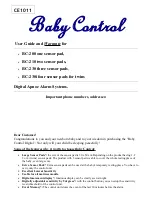
Image processing
Halftoning
For documents with many shade gradations (like a photograph) in
full-color mode (24-bit data), you can faithfully reproduce the image
on a full-color output device. Some output devices, such as 8-color PC
monitors or 8-color printers, cannot faithfully portray a full-color
image; however, a method does exist for approximating multiple
shades on these types of output devices.
For example, by adjusting black and white pixels slightly,
you can approximate various shades of gray between black
and white. This type of data processing is called halftone processing,
and several versions are available on EPSON scanners. Two typical
forms of halftone processing are dither processing and density pattern
processing. Dither processing is the normal type of data processing
found on scanners. EPSON scanners also represent halftones using
dither processing.
Halftone mode A
Halftone mode B
Overview
1-21
Summary of Contents for EMP-TW 1000
Page 4: ...iv ...
Page 11: ...Introduction Introduction 1 ...
Page 14: ...4 Introduction ...
Page 36: ...Halftone mode C None Dither mode A Dither mode B Dither mode C Dither mode D 1 22 Overview ...
Page 39: ...Chapter 2 Command Usage 2 Command Usage 2 1 ...
Page 72: ...Color page scanning Use when sending color page data 2 34 Command Usage ...
Page 95: ...Chapter 3 Command Reference 3 Command Reference 3 1 ...
Page 131: ...Parameter range Default value i 00H center Command Reference 3 37 ...
Page 157: ...Command Reference 3 63 ...
Page 163: ...Appendix A Interface Specifications A Interface Specifications A 1 ...
Page 182: ...A 20 Interface Specifications ...
Page 183: ...Appendix B Scanner Model Technical Data B Scanner Model Technical Data B 1 ...
Page 268: ...B 86 Scanner Model Technical Data ...
















































